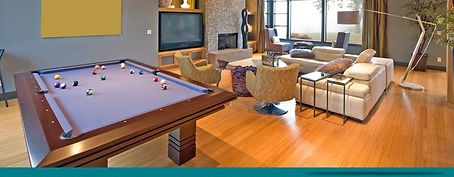

Our FAQs
While it might be tempting to move a pool table without disassembly, doing so can risk structural damage and affect the table's levelness. Our team uses specialized equipment and techniques to safely disassemble, transport, and reassemble your table with precision.
The felt on your pool table typically lasts 5-10 years, depending on usage and care. If you notice tears, significant wear, or uneven texture, it might be time to re-felt your table.
We move one-piece slate tables with care and skill. Our team carefully assesses factors like stairs, narrow doorways, or limited access to ensure safe and efficient transport. Any challenges will be communicated clearly to provide excellent service.
Yes, our expert technicians are equipped to install tables from any manufacturer. To ensure a smooth and correct assembly, all necessary parts must be included and fully compatible.
No special flooring is typically required for pool table installation. Our professionals can install on common surfaces like carpet, hardwood, tile, and concrete. The crucial factors for optimal gameplay and stability are ensuring the floor is stable enough to support the table's weight and is perfectly level.
If you notice the balls consistently rolling to one side or find it difficult to make straight shots, these are common signs that your pool table is no longer level. Over time, shifts in your flooring can affect gameplay by causing the table to become uneven.
A professionally installed pool table typically maintains its level for several years. However, various factors can necessitate re-leveling sooner. Moving the table, home renovations that impact flooring, or changes in humidity can all cause your pool table to become unlevel.
Yes! Our comprehensive full recover service revitalizes your pool table by replacing the high-quality cloth on the slate bed for optimal gameplay and expertly re-wrapping the rail cushions for an enhanced playing experience. We restore your pool table to its finest aesthetic and functional condition.
Pool table cushions typically last for 15 to 25 years. However, factors like heat and humidity can shorten their lifespan.
Cushions need replacement when they show "dead" rebounds, inconsistent bounce, or visible cracking in the rubber. This indicates wear, especially in older tables where rubber dries or hardens, significantly affecting gameplay.
To maintain optimal performance, you should brush the felt surface of your pool table at least once a week if used regularly. Use a brush designed specifically for pool tables to remove dust, chalk, and debris without damaging the felt.
Always use a pool table cover when the table is not in use to protect it from dust, spills, and sunlight, which can fade the felt. Additionally, avoid placing heavy or sharp objects on the table to prevent tears or dents.
Use a soft, damp cloth to gently wipe the wooden or leather railings and edges. For deeper cleaning, a mild wood cleaner can be applied. Avoid abrasive cleaners that could damage the finish.
No, avoid chalking your cue stick directly over the table to prevent excess chalk dust from settling on the felt, which can degrade its quality over time.
Pool table cushions are typically made from high-density rubber, designed to maintain consistent bounce and ball response. Standard cushions include K66, K55, and U23 profiles, varying in shape and responsiveness. Choosing the right cushion depends on your table's design and your preferred playing style.
To comfortably play, you’ll need to account for the table size and cue length. A general rule is to add at least 5 feet of clearance around all sides of the table. For example, a 7-foot table requires a room size of approximately 16 x 13 feet.
Slate pool tables feature a playing surface made from solid slate, offering superior durability and a perfectly flat surface for consistent play. Non-slate tables are typically more affordable but may have less precise playing surfaces and are best suited for casual use.
Essential accessories include durable pool cues, a rack for arranging the balls, a set of high-quality billiard balls, chalk for the cues, and a brush for maintaining the table’s surface. Optional extras include cue stands and pool table lighting for enhanced play.
Moving a coin operated pool table is typically more complex due to its heavier construction and built-in mechanisms, such as the coin system and ball return components. These additional parts often require specialized handling and equipment to ensure they are not damaged during transport. Standard pool tables, while also heavy, do not have these mechanisms, making them comparatively simpler to disassemble and move.
A 3-piece slate pool table consists of three individual sections of slate that are joined together during assembly, while a 1-piece slate table uses a single, continuous slab of slate for the playing surface. This structural difference plays a significant role in assembly and maintenance.
